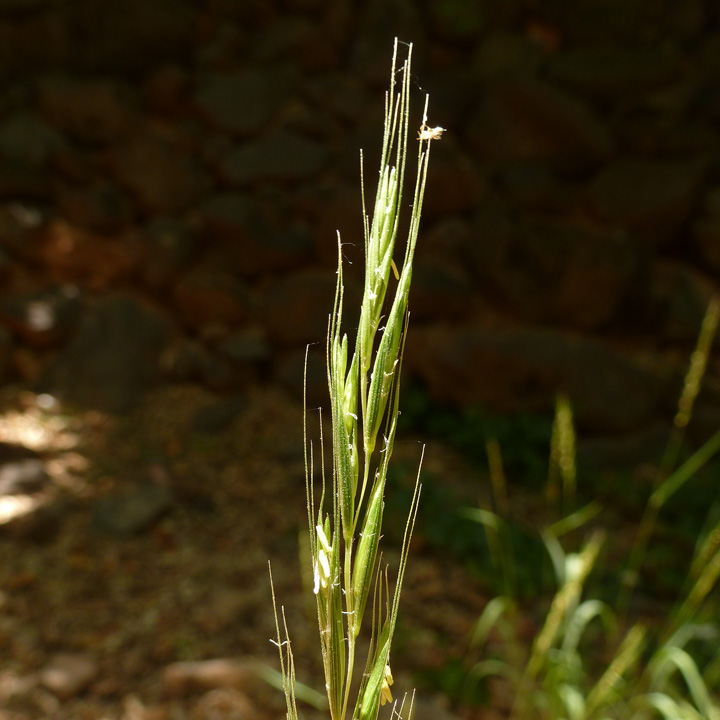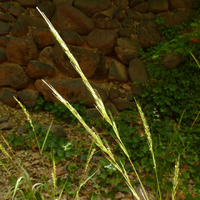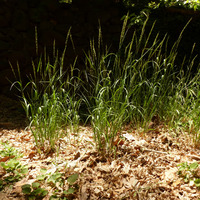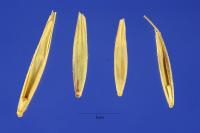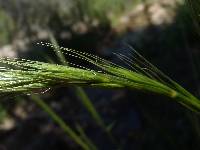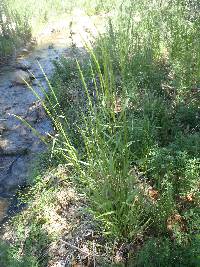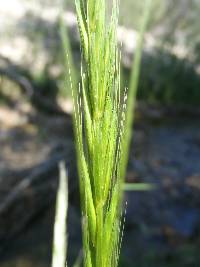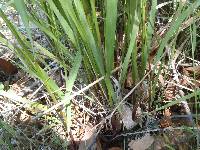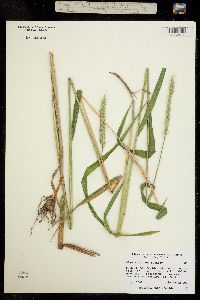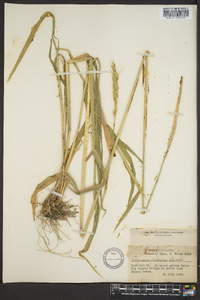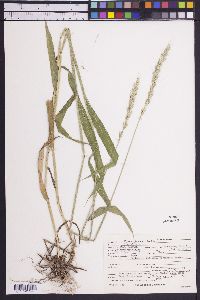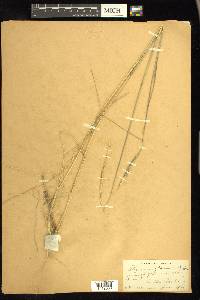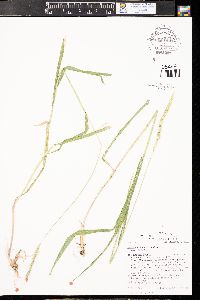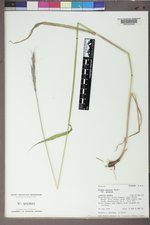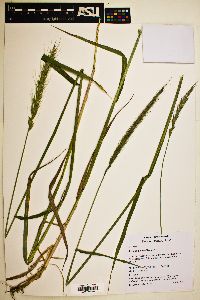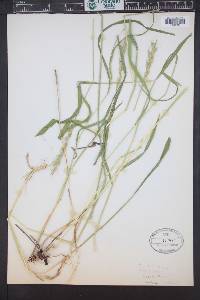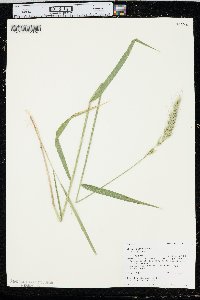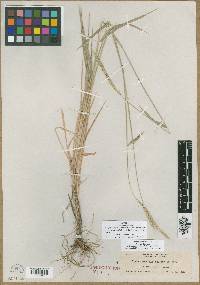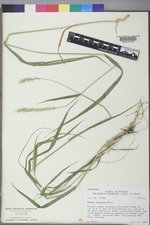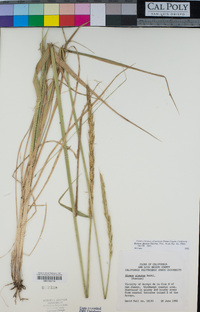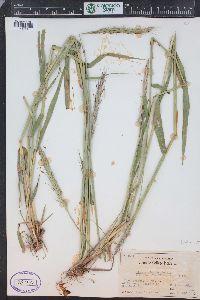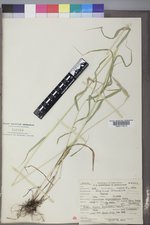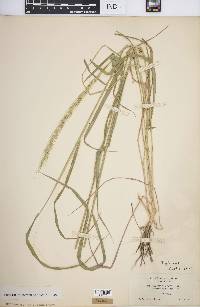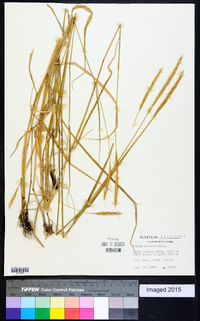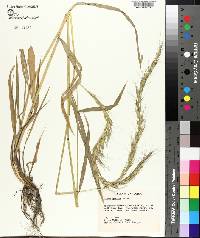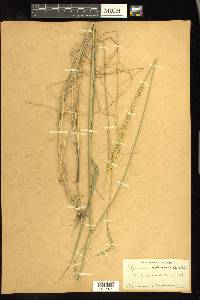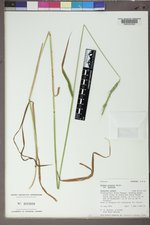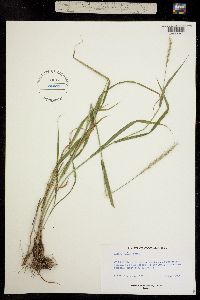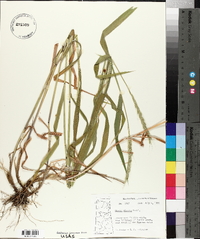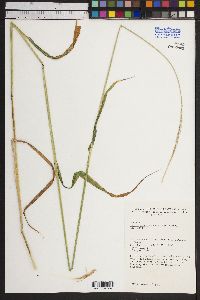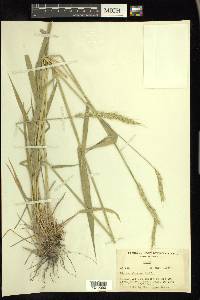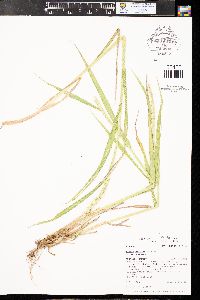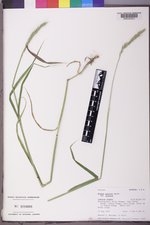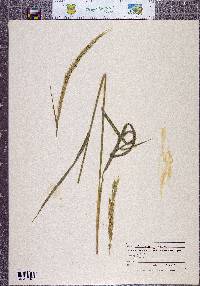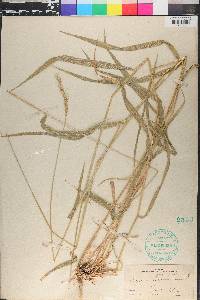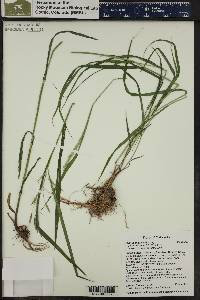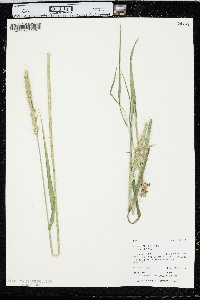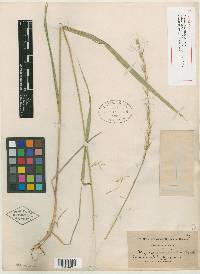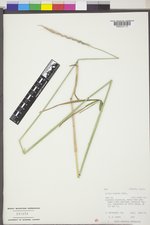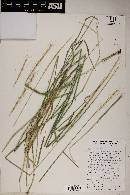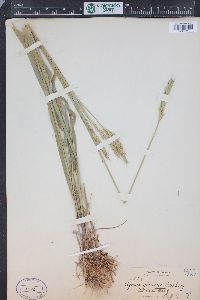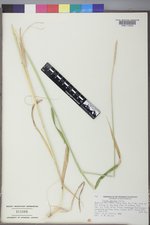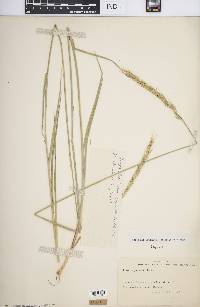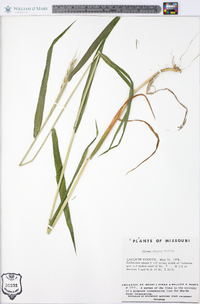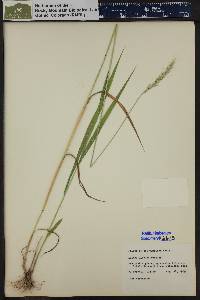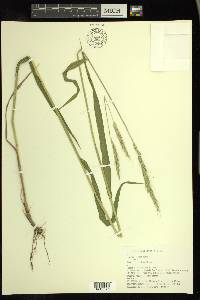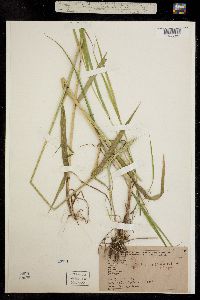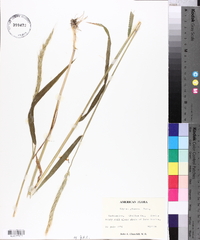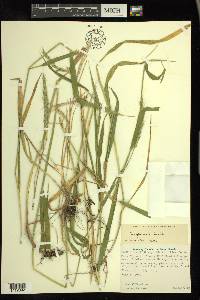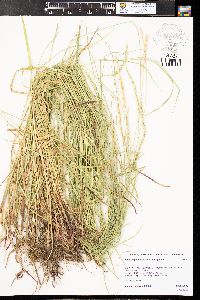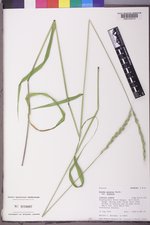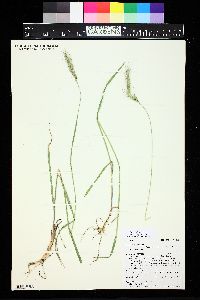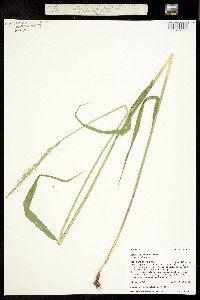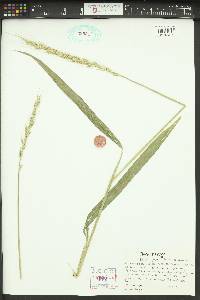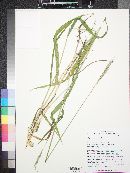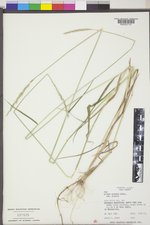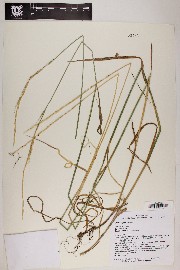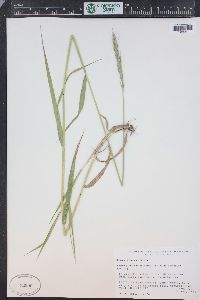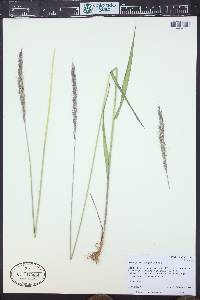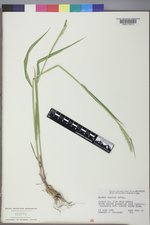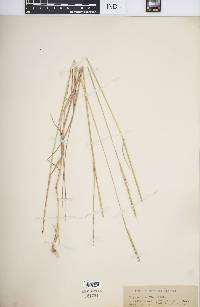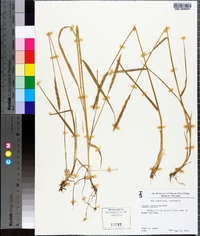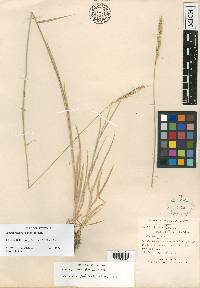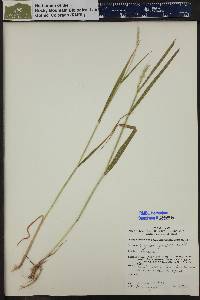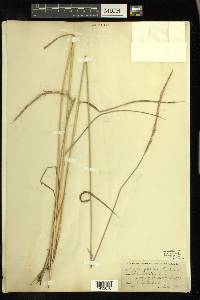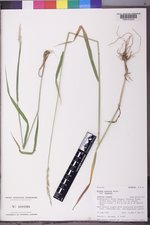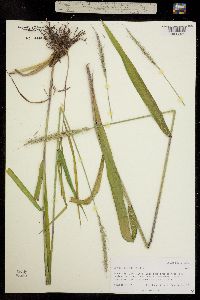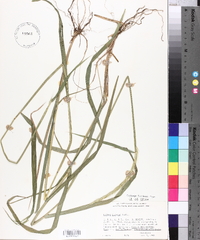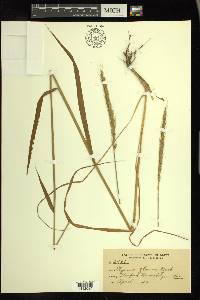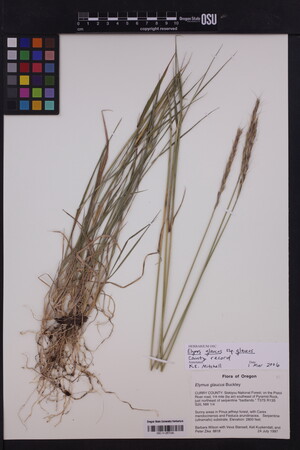Elymus glaucus
|
|
|
|
Family: Poaceae
Blue Wild Rye, more...blue wildrye, Common Western Wildrye
[Clinelymus glaucus subsp. coloratus, moreElymus americanus , Elymus angustifolius var. caespitosus Burtt Davy, Elymus edentatus , Elymus glaucus var. maximus Burtt Davy, Elymus marginalis , Elymus nitidus Vasey, Elymus petersonii , Elymus sibiricus var. americanus S. Watson & J.M. Coult., Elymus sibiricus var. glaucus (Buckley) Ramaley, Terrellia glauca (Buckley) Lunell] |
Plants densely to loosely cespitose, sometimes weakly rhizomatous, often glaucous. Culms 30-210 cm, erect or slightly decumbent; nodes 4-7, mostly exposed, usually glabrous, sometimes puberulent. Leaves evenly distributed; sheaths scabrous or smooth, glabrous or, particularly those of the lower leaves, retrorsely puberulent to hirsute, often purplish; auricles usually present, to 2.5 mm, often purplish; ligules to 1 mm, truncate, erose-ciliolate or entire; blades 2-13(17) mm wide, usually lax, sometimes slightly involute, adaxial surfaces glabrous, scabrous, or strigose on the veins, sometimes pilose to villous. Spikes 5-21 cm long, (0.2)0.5-2 cm wide, erect to slightly nodding, rarely somewhat pendent, usually with 2 spikelets per node, sometimes with 1 at all or most nodes, rarely with 3 at some nodes; internodes 4-8(12) mm long, 0.15-0.5 mm thick at the thinnest sections, angles scabrous, glabrous below the spikelets. Spikelets 8-25 mm, sometimes purplish at higher latitudes and elevations, appressed to slightly divergent, with (1)2-4(6) florets, lowest florets functional; disarticulation above the glumes and beneath each floret. Glumes subequal, 3/4 as long as or equaling the adjacent lemmas, bases often overlapping, usually flat and thin with evident venation, glume bodies (6)9-14(19) mm long, 0.6-1.5(2) mm wide, linear-lanceolate, entire, widening above the base, (1)3-5(7)-veined, 2-3 veins extending to the apices, glabrous, veins smooth or evenly scabrous, margins 0.1-0.2 mm wide, whitish hyaline, tapering towards the apices, unawned or awned, awns to 5(9) mm, straight; lemmas (8)9-14(16) mm, glabrous, scabrous, or short-hirsute, awns (0)1-30(35) mm, usually straight to flexuous, sometimes slightly curving; paleas 7-13 mm, keels straight or slightly concave, usually scabrous to ciliate, apices often bidentate; anthers 1.5-3.5 mm. Anthesis from May to July. 2n = 28. Elymus glaucus grows in moist to dry soil in meadows, thickets, and open woods. It is widespread in western North America, from Alaska to Saskatchewan, and south to Baja California and New Mexico. It is also sporadic, sometimes appearing transitional to E. trachycaulus , from the northern Great Plains to southern Ontario and New York and, as a disjunct, on rocky sites in the Ozark and Ouachita mountains. Populations can differ greatly in morphology, especially in rhizome development, leaf width, pubescence, and the prevalence of solitary spikelets; their crossing relationships are partly correlated with such variation (Snyder 1950, 1951; Stebbins 1957, Wilson et al. 2001). Rhizome development and the production of solitary spikelets may also be environmental responses. Rhizomatous plants are more common on unstable slopes or sandy soils. Plants with solitary spikelets are more common on poor soil or in shade. They are often confused, particularly in the herbarium, with E. stebbinsii -or E. trachycaulus . They differ from E. stebbinsii in their shorter anthers and awned glumes. Distinction from E. trachycaulus can be difficult with herbarium specimens, but is generally easy in the field, E. glaucus having more evenly leafy culms, laxer and wider blades, more tapered glumes that are almost always awned, and shorter anthers than the sympatric E. trachycaulus. There are reports of natural hybrids with several other species of Elymus, including E. elymoides , E. multisetus -(see E. -hansenii , p. --), E. trachycaulus, and E. stebbinsii. These hybrids often appear at least partially fertile. Elymus glaucus can also form intergeneric hybrids with Leymus -and Hordeum -(see -Elyleymus , p. --, and -Leydeum , p. --). Grasses of the Intermountain Region p. 65 Plants perennial, forming loose clumps, usually with fewer than 30 culms per clump, sometimes weakly rhizomatous. Culms 30-140 cm tall, erect to slightly decumbent; nodes 4-7, most exposed, usually glabrous, sometimes puberulent. Leaves evenly distributed; sheaths often purplish, scabrous or smooth, glabrous or, particularly those of the lower leaves, retorsely puberulent to hairy; auricles usually present on the lower leaves, up to 2.5 mm long, often purplish; ligules up to 1 mm long, truncate, erose-ciliolate or entire; blades 2-13(17) mm wide, usually lax, sometimes loosely involute, adaxial (upper) surface glabrous, pilose, or vilolous, sometimes strigose over the veins. Inflorescence spicate, 5-21 cm long, (0.2)0.5-2 cm wide, erect to slightly nodding, usually with 2 spikelets per node, sometimes with 1 at all or almost all nodes, occasionally with 3 at some nodes; internodes 4-8(12) mm long, 0.15-0.5 mm thick at the thinnest portion, angles scabrous, surfaces glabrous, below the spikelets. Spikelets 8-25 mm long, usually green, sometimes purplish at high latitudes and elevations, appressed to slightly divergent, lowest floret fully functional; disarticulation above the glumes, beneath each floret. Glumes subequal, glabrous and smooth throughout or scabrous over the veins, 3/4 as long as or equalling the adjacent lemma, bases often overlapping, usally flat and thin, with evident venation, glume body (6)9-14(19) mm long, 0.6-1.5(2) mm wide, linear-lanceolate, widening above the base, entire, (1)3-5(7)-veined, 2-3 veins extending to the glume tip, margins 0.1-0.2 mm wide, whitish to hyaline, tapering towards the tip; glumes tips unawned or awned, awns to 5(9) mm long, straight; lemmas (8)9-14(16) mm long, glabrous, scabrous, or shortly hairy; lemma tips usually awned, 1-30(35) mm long, usually straight to flexuous, sometimes slightly curving; paleas 7-13 mm long, keeks straight to slightly concave, usually scabrous, sometimes shortly ciliate, tips narrow, often bidentate; anthers 1.5-3.5 mm long. Flowering May to July. FNA 2007, Gould 1980 Common Name: blue wildrye Duration: Perennial Nativity: Native Lifeform: Graminoid General: Perennial plants densely to loosely cespitose, sometimes weakly rhizomatous, often glaucous with stems 30-140 cm, erect or slightly decumbent; nodes 4-7 mostly exposed, usually glabrous, sometimes puberulent. Vegetative: Leaves evenly distributed, sheaths scabrous or smooth, glabrous or retrorsely puberulent to hirsute, often purplish lower leaves; auricles to 2.5 mm, often purplish, ligules to 1 mm, truncate, erose-ciliolate or entire; blades 2-13 mm wide, usually lax, s Inflorescence: Spikes 5-21 cm long, 0.5-2 cm wide, erect to slightly nodding, rarely pendent, with 2 spikelets per node, sometimes with 1 rarely with 3 are some nodes; internodes 4-8 mm long; spikelets 8-25 mm, purplish in higher elevation plants, appressed to slightly divergent with 2-4 florets, disarticulation above the glumes and beneath each floret; glumes subequal, 9-14 mm long, 0.5-1.5 mm wide, linear-lanceolate, entire, awns 1-30 mm long, usually straight to flexuous, sometimes slightly curving. Ecology: Found in dry to moist soil in canyons, woodlands, and meadows from 3,000-8,000 ft (914-2438 m); flowers May-July. Notes: The auricles help to identify this species, with its wide purple auricle. There is one subspecies in the region: ssp. glaucus. This is distinguished by the blades usually 4-17 mm wide, with upper surfaces glabrous or strigose, occasionally pilose to hirsute with hairs of fairly uniform length; glume awns 1-5 mm long, and lemma awns 10-25 mm. Ethnobotany: Seeds parched and pounded into flour, or used in pinole. Etymology: Elymus comes form Greek name elymos for millet, while glaucus means glaucous, from the Greek meaning bluish-gray. Synonyms: None Editor: SBuckley, 2010 Green to glaucous, tufted, 6-14 dm; lvs ±flat, 4-12 mm wide, glabrous to scabrous; auricles mostly well developed, ca 2 mm and clasping the stem; spikes 6-16 cm, erect, compact or loose below, spikelets mostly paired, 10-16 mm, 2-3(4)-fld; glumes subequal, (6.5-)9-14+ mm, narrowly lanceolate, broadest above the flat, sometimes slightly indurate base, 3-5-veined, almost parallel and concealing the base of the subtended florets, glabrous to scabrous, tapering into a short awn; lemmas 8.5-12+ mm, 5-nerved above, glabrous to scabrous on the nerves, tapering into a slender, usually straight awn (10-)14-22(-30) mm; larger paleas 5.5-8.5 mm; anthers 1.7-3 mm; 2n=28. Open woods, moist meadows, and dry hillsides; widespread in the w. cordillera, e. less commonly to Ark., Io., n. Mich., Ont., and w. N.Y. Gleason, Henry A. & Cronquist, Arthur J. 1991. Manual of vascular plants of northeastern United States and adjacent Canada. lxxv + 910 pp. ©The New York Botanical Garden. All rights reserved. Used by permission. |
|
|
|

